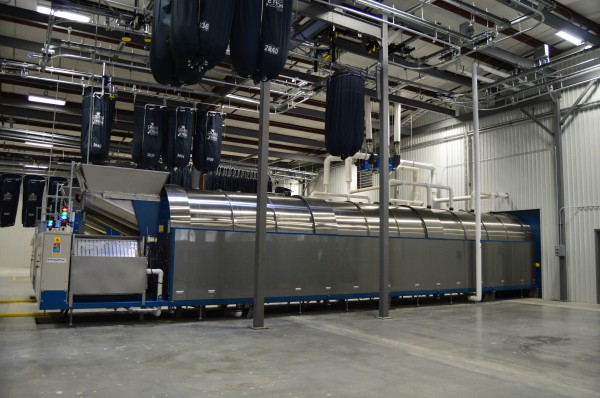
By Mike Diedling
Manager, Applications Engineering Dept., Pellerin Milnor Corporation
Has your laundry increased in the amount of goods it processes yearly? Are you looking to purchase new equipment to handle the extra poundage? If you’re like any other Laundry Manger, you may be wondering if it is time to add a tunnel to your line of equipment.
There are several things to take into consideration when making the leap from washer extractors to a tunnel, adding a tunnel to your line of equipment or building a new laundry with a tunnel washer.
Understandably, most laundry managers seek out the least expensive combination of equipment and operating costs (water, sewer, fuel, chemicals, and labor) over the life of the equipment. For many, with small quantities of goods to process, the initial solution is a washer extractor with manual dryers. If the hourly production requirement grows, you can certainly increase either the quantity or the size of your washer extractors…or both. The same holds true for drying capacity.
But at some point, you may be asking yourself if the amount of goods you process justifies the purchase of a tunnel washer. Typically that threshold is somewhere between 1000 and 2000 lbs. per hour production requirement.
How do you decide? Many individuals will seek out a break-even point. Exactly where that point is will depend on the calculated savings that can be realized with a tunnel for the same factors used when you purchased your washer extractors, i.e. water, sewer, fuel, chemicals, and labor.
At higher production volumes (approximately 2500-3000 lbs. per hour) tunnels become the least expensive washing equipment to purchase, but at low production volumes, tunnels can still be justified because they are extremely frugal with consumables. Additionally, because they are automated, they require less labor.
Some helpful hints when contemplating the addition of a tunnel solution to your laundry are:
1. Tunnels should typically wash about 90 percent of the required production volume. The remainder should consist of small quantities of various items that are best handled in a small washer extractor or two.
2. It is not necessary to purchase an entire system including a shuttle and
dryers. Many small tunnel systems consist of a loading device, a tunnel and an extractor. The extracted goods are moved via cart or sling to conventional dryers.
3. If a tunnel is planned for a new building, it is prudent to consider any additional money that can be saved due to the reduced water and fuel consumption attributable to the tunnel. This would include smaller boilers, water softeners, and heat reclaimers which in turn results in smaller internal piping for water, steam, condensate and natural gas. Utility connections to the building (water, sewer, and natural gas) can be downsized also.
4. Tunnel installation costs are often less than an appropriate compliment of washer extractors because a tunnel has the same number of water, power, steam and compressed air connections as one washer extractor.
5. You don’t need a second tunnel for backup. Tunnels have developed a reliability reputation like air compressors and boilers.
If you process in excess of 1000 lbs. per hour or more of goods, you owe it to yourself to investigate a tunnel…especially if you are in areas where high water, sewer, fuel, or labor costs exist. You may find that the best washer extractor solution for you is not a washer extractor.
************
Mike Diedling is Manager of the Applications Engineering Department at Pellerin Milnor. He is responsible for all functions of Applications Engineering, including equipment sizing calculations, layouts, and Return on Investment (ROI) calculations to determine the viability of various project alternatives for the customer.













